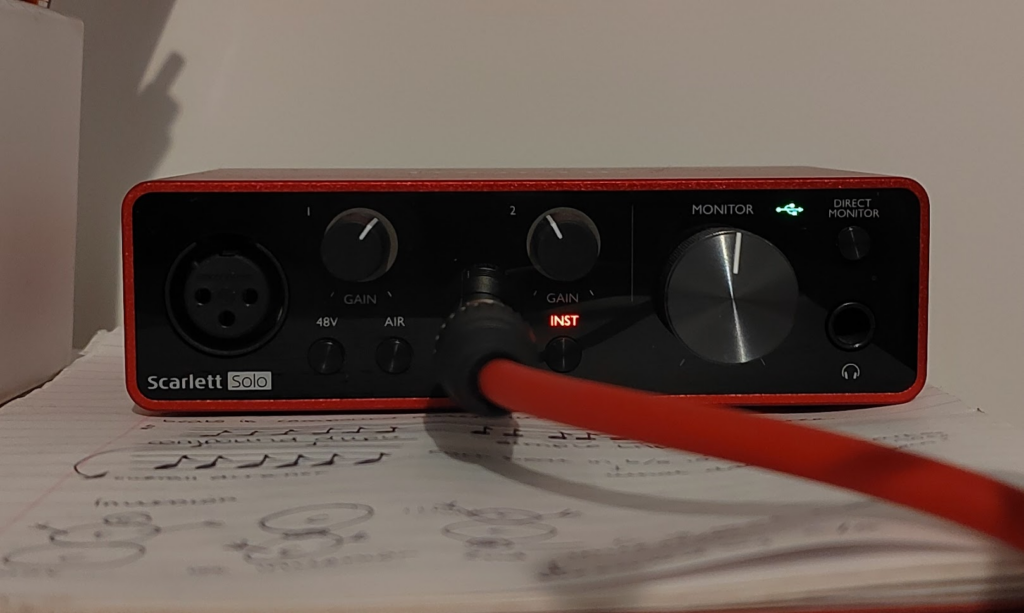Drums

We set up the drum kit initially in quite a messy way but made sure to neatly organise which microphone went to which input. In this photo, we mic’d up the kick, snare, every tom and two overheads equal distance from the centre of the snare.
The distance from all of the toms to individual microphones was about an inch, the snare microphone was a little further back because we were worried about Cody hitting it.
The kick’s microphone is in the direct middle of the hole, not touching any edges. The bases of the stands are raised so that they don’t touch the floor either, which reduces the risk of noise, though the floor tom’s stand fell back down.
In the end recording, we double checked the bases of the stand, measured accurately how far each overhead microphone was from the centre of the snare and removed the middle tom microphone as Cody didn’t use it and it was effectively just picking up noise. This is how the final set-up sounded:
To me, the kick has a lot of bass to it, the toms sound crisp and clear, the symbols sound clean and the snare sounds impactful. Because the recording sounds good, it shouldn’t be too hard to mix.
Guitar
Since we spent most of our time in the studio focusing on drums, I’ll be recording guitar at home with my own equipment.

The plan is to use a AKG P120 microphone, which is a cardioid condenser microphone, to record directly from my amp. Although a dynamic microphone would be more suitable, the AKG has a -20db switch which means I can record audio this close and at a loud volume and have very minimal noise while playing.
I’ll be plugging this into a Scarlett Solo audio interface using an XLR cable and I will be using Logic Pro X to record audio.
I want to record this way as it feels easier to play with confidence knowing what I’m hearing is how it will sound recorded, as I can shape the tone with ease and play without worrying about certain sensitive sounds that recording with DI would pick up, like the sound of the pickup switch. Additionally, I might find that it sounds more authentic and has a less muddy sound.
An alternative option would be to DI guitar through the Scarlett Solo and use Logic to form the preferred tone.

Bass
To record bass, I’ll DI through the Scarlett to Logic and form a tone through that. I want to do this as I know using this method would pick up lower frequencies much better and it is much easier than trying to record bass through an amp while battling with noise, such as any amp noise or rattling objects.
Vocals
We’ll be recording vocals in the studio using a condenser microphone and running it through the desk to Logic. This will most likely be just Cody in the studio, unless he’s comfortable with me being around, setting up and pressing record for him.
To avoid noise bleeding through, we’ll use headphones or earphones at a comfortable level and check that no audio is picked up through the microphone before we start recording.
Other ideas were to record using a low quality microphone, like built-in earphone microphones to record a gritty and lightly distorted sound. This would be fitting for the song, but it risks clipping and sounding too compressed when mixed.

To record vocals, I’ve set up a Behringer c-1 condenser microphone plugged into a Scarlett Focusrite audio interface which I’ve set as Logic’s primary input. The headphones are used to reduce the risk of audio bleed through so that the recording doesn’t pick up the song and create a muddy sound during playback. It makes it much easier to mix as the noise gate will work as it should rather than struggle to identify which audio should be filtered out and we won’t have to compress as much.
Just in case we don’t get that done, I thought I’d set up at home too, as a backup in the event that Cody doesn’t record vocals. This will be a really big test of self confidence, as if I record anything to an okay standard, I’ll have to learn to be comfortable with people hearing my voice.